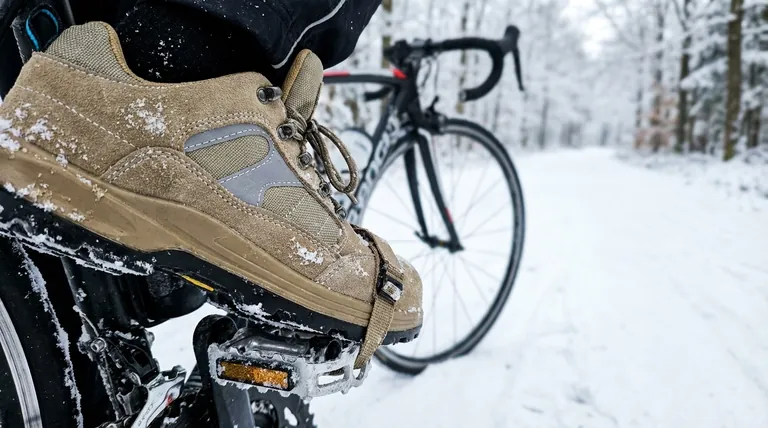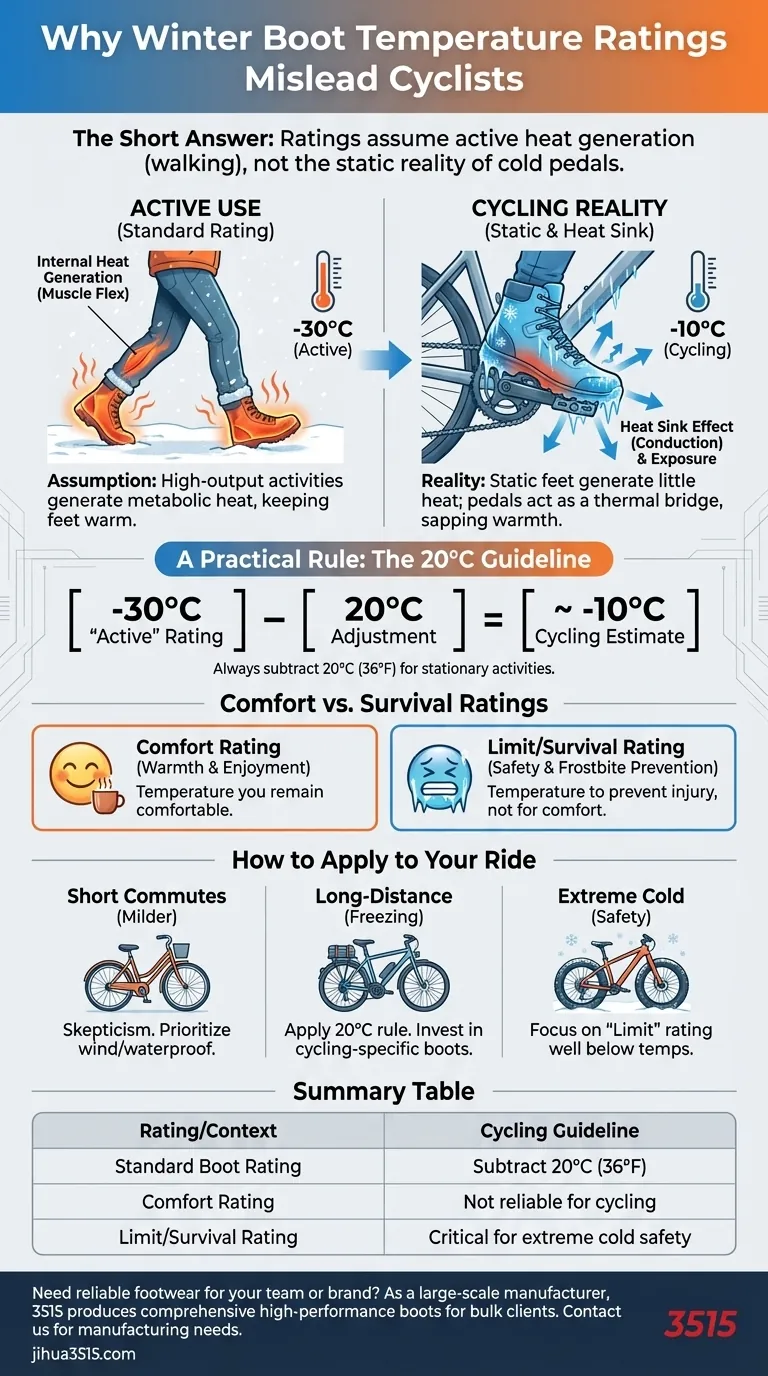The short answer is this: Boot temperature ratings are fundamentally misleading for cyclists because they are almost always based on the heat generated during active walking, not the static reality of resting your feet on cold, heat-sapping metal pedals.
The temperature rating on a winter boot is a benchmark for a different activity entirely. For a cyclist, who remains largely stationary from the ankle down, that number is not a guarantee of comfort but a starting point that requires significant downward adjustment.

Why Standard Ratings Fail for Cyclists
To stay warm, you must understand the environment a boot rating assumes versus the unique thermal challenges of cycling. The discrepancy is where the danger lies.
The "Active Use" Assumption
Most temperature ratings are determined for high-output activities like vigorous walking, snowshoeing, or hiking.
During these activities, the constant flexing of muscles in your feet and lower legs generates a substantial amount of metabolic heat, keeping your extremities warm from the inside out.
The Static Reality of Cycling
When you cycle, your feet are mostly locked in place. There is very little muscle contraction happening within the foot itself.
This lack of movement means your feet generate significantly less internal heat, making them far more reliant on insulation alone to stay warm.
The Heat Sink Effect
Your pedals, especially if made of metal, act as a thermal bridge, actively pulling heat away from your feet through a process called conduction.
Essentially, your feet are in direct contact with a cold object that is constantly exposed to freezing air, creating a powerful and continuous cooling effect that boot ratings do not account for.
A Practical Rule for Adjustment
Since the advertised rating is unreliable for cycling, you need a more realistic framework for evaluating a boot's performance.
The 20°C Guideline
A sound rule of thumb is to subtract 20°C (about 36°F) from a boot's "active" temperature rating to estimate its performance for stationary activities like cycling.
If a boot is rated for -30°C during active use, you should consider it appropriate for only about -10°C on the bike.
Comfort vs. Survival Ratings
It's also critical to know what the rating means. Some ratings indicate the temperature at which you'll remain comfortable, while others indicate a limit temperature for preventing frostbite.
These are two very different standards. A "limit" rating is about safety and survival, not warmth and enjoyment. Always seek clarity on which standard the manufacturer is using.
How to Apply This to Your Ride
Choosing the right footwear isn't just about the number on the box; it's about matching your system to the conditions and your activity level.
- If your primary focus is short commutes in milder winter conditions: A standard winter boot may suffice, but treat its temperature rating with skepticism and prioritize windproof and waterproof features.
- If your primary focus is long-distance riding in freezing weather: Apply the 20°C reduction rule rigorously or invest in cycling-specific winter boots designed to address heat loss through the sole and cleat.
- If your primary focus is maximum safety in extreme cold: Ignore comfort ratings entirely and focus on a boot's "limit" or "survival" rating, ensuring it is well below the coldest temperature you expect to encounter.
Ultimately, a temperature rating is a single data point, and your safety depends on understanding the context that data is missing.
Summary Table:
| Rating Type | Assumed Activity | Cycling Reality | Practical Guideline |
|---|---|---|---|
| Standard Boot Rating | Vigorous walking, high heat generation | Feet are static on cold pedals, low heat generation | Subtract 20°C (36°F) from the rating |
| Comfort Rating | Temperature for warmth during activity | Not a reliable indicator for cycling | Prioritize windproof and waterproof features |
| Limit/Survival Rating | Temperature to prevent frostbite | Critical for safety in extreme cold | Ensure rating is well below expected temperatures |
Need reliable footwear for your cycling team or retail brand? As a large-scale manufacturer, 3515 produces a comprehensive range of high-performance boots and shoes for distributors, brand owners, and bulk clients. Our production capabilities encompass all types of cycling-specific footwear designed to combat the unique thermal challenges of winter riding. Let us help you equip your customers with gear they can trust. Contact our team today to discuss your manufacturing needs.
Visual Guide

Related Products
- Wholesale Safety Boots Manufacturer for Custom & Private Label Orders
- High Performance Fire-Retardant Waterproof Safety Boots
- Premium High-Cut Waterproof Safety Boots Manufacturing & Wholesale Solutions
- Customizable Anti-Smash Safety Boots for Wholesale & Private Label Manufacturing
- Factory-Direct Wholesale Canvas Boots with High-Traction Rubber Soles
People Also Ask
- What advice is given for selecting the right boots? A Step-by-Step Guide to Finding Your Perfect Fit
- What are the consequences of not wearing safety shoes? Protect Your Feet from Severe Workplace Injuries
- What type of personal protective equipment does OSHA require? A Guide to Hazard-Based Compliance
- What makes oilfield boots versatile for other industries? Unpacking Their Cross-Industry Value
- What tips should be followed when buying oilfield work boots? Choose the Right PPE for Safety & Comfort



















